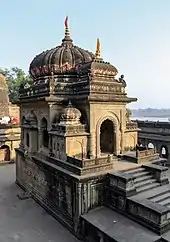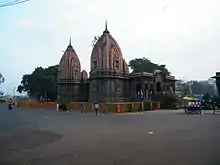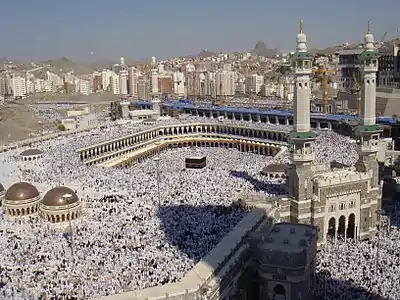Chhatri
Chhatri are elevated, dome-shaped pavilions used as an element in Indian architecture. The word literally means "canopy" or "umbrella." In the context of architecture, the word is used to refer to two different things. The usual and more widely understood meaning is of a memorial, usually very ornate, built over the site where the funeral (cremation) of an important personage was performed. Such memorials usually consist of a platform girded by a set of ornate pillars which hold up a stone canopy.
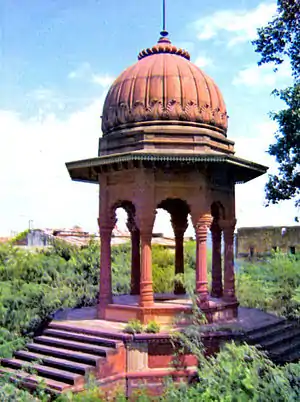

The word chhatri is also used to refer to the small pavilions that mark the corners and roof of the entrance of a major building. These pavilions are purely decorative and have no utility, but are a classic folly displaying the status and wealth of the owner.
Chhatris are commonly used to depict the elements of pride and honour in Rajput, Maratha and Jat architecture. They are widely used in palaces, in forts, or to demarcate funerary sites. Originating in Rajasthani architecture where they were memorials for royalty, they were later adapted as a standard feature in all buildings in Maratha-ruled states, Rajasthan, and in Mughal architecture. The most notable surviving examples today are to be found at Humayun's Tomb in Delhi and the Taj Mahal in Agra.
Chhatris in Shekhawati may consist of a simple structure of one dome raised by four pillars to a building containing many domes and a basement with several rooms. In some places, the interior of the chhatris is painted in the same manner as the havelis (mansions) of the region.
In Rajasthan
.jpg.webp) A 12th-century chatri, Jaisalmir
A 12th-century chatri, Jaisalmir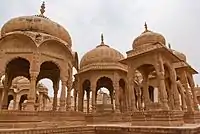 Bada Bagh at Jaisalmer
Bada Bagh at Jaisalmer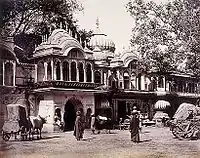 Chhatri at Rajgarh, Rajasthan
Chhatri at Rajgarh, Rajasthan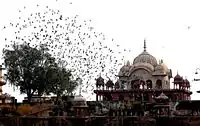 Moosi Rani Ki Chhatri, Alwar
Moosi Rani Ki Chhatri, Alwar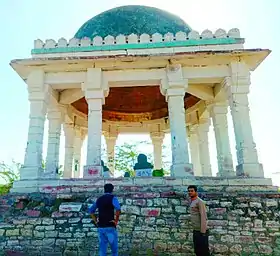 Barah Khamba Chhatri at Jalsen Talab in Hindaun
Barah Khamba Chhatri at Jalsen Talab in Hindaun
Many other chhatris exist in other parts of Rajasthan. Their locations include:
- Jaipur – Gaitore Cenotaphs of the Maharajas of Jaipur. Set in a narrow valley, the cenotaphs of the former rulers of Jaipur consist of the somewhat typical chhatri or umbrella-shaped memorials. Sawai Jai Singh II's Chhatri is particularly noteworthy because of the carvings that have been used to embellish it.
- Jodhpur – Jaswant Thada, the white marble chhatri of Maharaja Jaswant Singh II
- Bharatpur- the cenotaphs of the members of the Jat royal family of Bharatpur, who perished whilst fighting against the British in 1825, are erected in the town of Govardhan. The chhatri of Maharaja Suraj Mal of Bharatpur has fine frescos illuminating the life of Surajmal, vividly depicting darbar and hunting scenes, royal processions and wars.
- Udaipur- Flanked by a row of enormous stone elephants, the Lake Pichola island has an impressive chhatri carved from gray blue stone, built by Maharana Jagat Singh.
- Haldighati – A beautiful Chhatri with white marble columns, dedicated to Rana Pratap, stands here. Chetak Smarak, the cenotaph dedicated to Chetak, Rana Pratap's famous horse, is also noteworthy.
- Alwar – Moosi Maharani ki Chhatri is a beautiful red sandstone and white marble cenotaph of the rulers of Alwar.
- Bundi – Suraj Chhatri and Mordi Ki Chhatri, Chaurasi Khambon ki Chhatri, Bundi and Nath Ji ki Chhatri are located in Bundi. Rani Shyam Kumari wife of Raja Chhatrasal on the northern hill constructed the Suraj Chhatri and Mayuri the second wife of Chhatrasal on the southern hill erected Mordi Ki Chhatri.
- Jaisalmer – Bada Bagh, a complex with chhatris of Jai Singh II (d. 1743) and subsequent Maharajas of Jaisalmer.
- Bikaner – Devi Kund near Bikaner is the royal crematorium place with a number of cenotaphs. The chhatri of Maharaja Surat Singh is most imposing. It has the spectacular Rajput paintings on the ceilings.
- Ramgarh – Seth Ram Gopal Poddar Chhatri
- Nagaur – Nath Ji ki Chhatri, Amar Singh Rathore-ki-Chhatri
In Shekhawati
Some of the best-known chhatris in the Shekhawati region of Rajasthan are located at the following cities and towns:
- Ramgarh – Ram Gopal Poddar Chhatri
- Laxmangarh - Churiwala ki Chhatri
- Bissau – The Raj ki Chhatri of the Shekhawat Thakurs
- Parsurampura – Thakur Sardul Singh Shekhawat's chhatri
- Jhunjhunu – Chhatri of Shekhawat Rulers
- Dundlod – The beautiful chhatri of Ram Dutt Goenka
- Mukungarh – Shivdutta Ganeriwala Chhatri
- Churu – Taknet Chhatri
- Mahansar – The Sahaj Ram Poddar Chhatri
- Udaipurwati – Joki Das Shah ki Chhatri
- Fatehpur – Jagan Nath Singhania Chhatri
In Madhya Pradesh
The region of Madhya Pradesh is the site of several other notable chhatris of its famous Maratha rulers:
- Shujalpur – Tomb of Ranoji Scindia, founder of the Scindia dynasty. Situated at Ranoganj, Shujalpur to Akodia Road.
- Shivpuri – Intricately embellished marble chhatris erected by Scindia rulers in Shivpuri.
- Gwalior – Shrimati Balabai Maharaj Ladojirao Shitole Chhatri
- Gwalior – Rajrajendra Ramchandrarao Narsingh Shitole and wife Gunwantyaraje Ramchandrarao Shitole (princess of Gwalior) Chatri
- Orchha – Elaborate chhatris of local Hindu kings
- Gohad – The Jat rulers of Gohad constructed the chhatri of Maharaja Bhim Singh Rana on the Gwalior Fort.
- Indore and Maheshwar – Chhatris of Holkar rulers.
- Alampur – Maharani Ahilya Bai Holkar built the chhatri of Malhar Rao Holkar at Alampur in Bhind district in 1766.
 Bolia Maharaj Ki Chhatri, Indore |
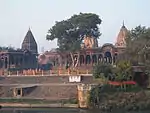 Krishnapura Chhatri, Indore |
 Inside view of Krishnapur Chhatri, Indore |
In Maharashtra
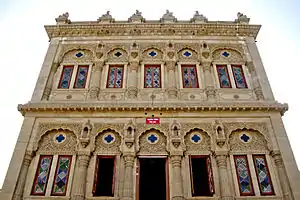
- Wanwadi – Memorial dedicated to Mahadji Shinde, an 18th century Maratha statesman and ruler of Ujjain in Central India. He was the fifth and the youngest son of Ranoji Rao Scindia, the founder of the Scindia dynasty. The memorial is situated at Wanwadi in Pune.
Mughal architecture
Chhatri were features in many buildings of Mughal architecture:
- The Panch Mahal, Fatehpur Sikri is crowned with a domed chhatri that overlooks the men's area.[1]
In Kutch

Chhatris can also be found in the outskirts of Bhuj city belonging mainly to Jadeja rulers of Kutch. The chhatri of Rao Lakhpatji is very famous for its intricate designs & carvings. Most of them but have been destroyed in the 2001 Gujarat earthquake. The restoration work is going on.
Outside India
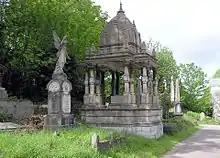
There are two notable chhatris in the United Kingdom, a country with strong historical links to India. One is a cenotaph in Brighton, dedicated to the Indian soldiers who died in the First World War.
The other is in Arnos Vale Cemetery near Bristol and is a memorial to the distinguished Indian reformer Raja Ram Mohan Roy, who died in that city.
References
- Andrew Petersen (11 March 2002). Dictionary of Islamic Architecture. p. 83. ISBN 9781134613663.
External links
| Wikimedia Commons has media related to Chhatri. |
- ArchNet Dictionary of Islamic Architecture: Chatri
- Images of old chhatris Columbia University
